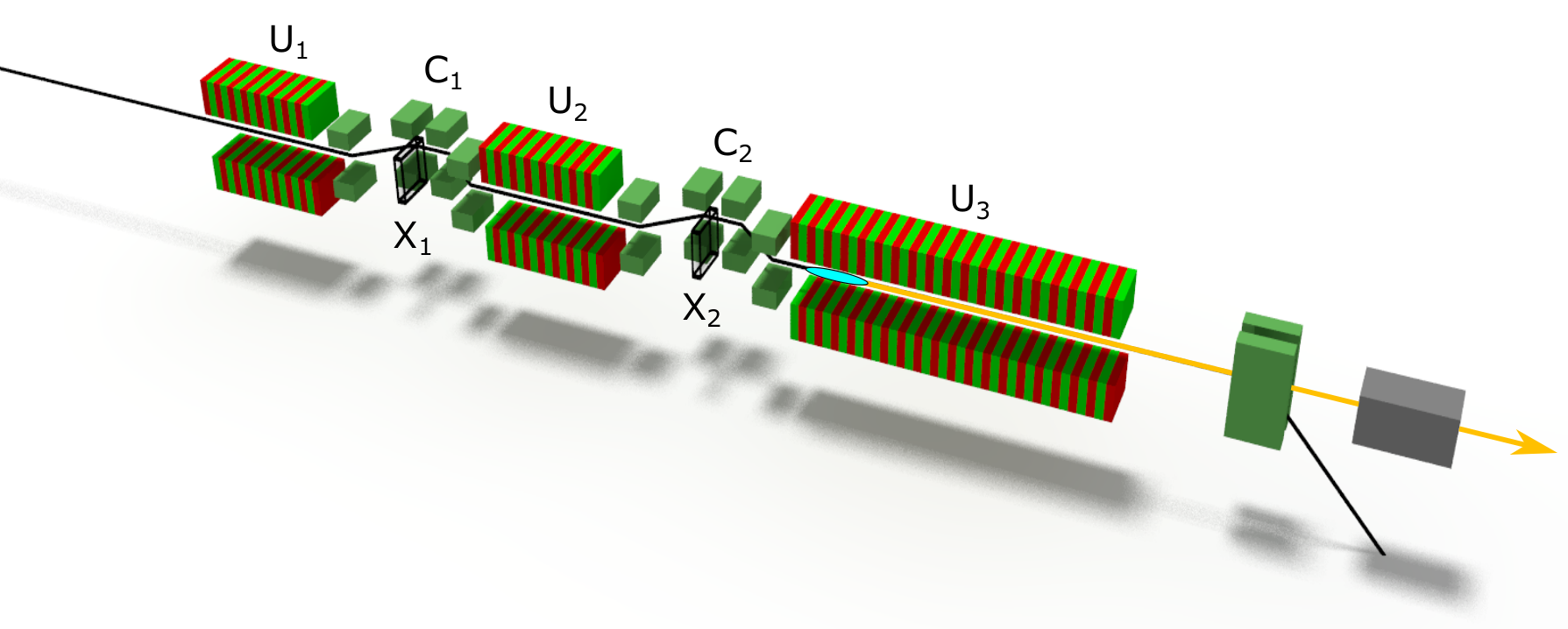Setup enables optimal use of accelerator to generate brighter X-ray flashes
An international team of scientists at DESY and European XFEL has demonstrated a device to significantly increase the amount of X-rays with sharply defined wavelengths generated by an X-ray laser at high repetition rates. The novel cascaded setup opens up new experimental possibilities in a wide range of scientific fields employing ultrafast X-ray spectroscopy, scattering and imaging techniques.

Layout of the cascaded HXRSS setup at the European XFEL, comprising three undulator segments (U1, U2, and U3) and two magnetic chicanes (C1 and C2) with thin diamond crystals (X1 and X2). These create a narrow-bandwidth notch in the spectrum, which is then amplified in the subsequent undulator section, resulting in bright X-ray pulses with sharply defined wavelengths. (Picture: European XFEL)
To explore the physical and material properties of samples on the time scale of femtoseconds, scientists need light sources that provide X-rays flashes at very high repetition rate, with short pulse durations and a spectral flux—i.e. the rate at which X-ray photons of a given wavelength are emitted by the source—significantly larger than what has been available at X-ray laser sources around the world so far. Using a sophisticated, cascaded Hard X-Ray Self-Seeding (HXRSS) setup, a team led by European XFEL succeeded in generating very bright X-ray flashes at the high repetition rates of the European XFEL accelerator.
In a conventional HXRSS setup, electron bunches from a linear accelerator generate X-ray radiation in a first magnetic arrangement—the first undulator section—according to the self-amplified spontaneous emission (SASE) scheme. A special filtering process selects only a narrow wavelength range of the radiation, which is then fed as a "seed" into a second undulator section, where it is amplified again. However, due to the high (megahertz) repetition rate of the European XFEL, the diamond crystal that constitutes the main part of the filtering setup heats up, resulting in a shift and a deformation of the range of selected wavelengths.
This unwanted effect was now studied for the first time and demonstrated to be important at X-ray wavelengths longer than 1.5 angstrom. In order to avoid it, an international team of scientists at the European XFEL realized a cascaded setup, where the filtering process is repeated with a second crystal and a final undulator section. In the end, the setup generated thousands of X-ray pulses per second with very narrow spectral bandwidth—i.e. sharply defined wavelength—and an average spectral brightness that was about two orders of magnitude higher compared to any other such X-ray laser facility worldwide.
"We are very happy that hard X-ray self-seeding has now also become reality at European XFEL, more than 10 years after its first theoretical description by a team of DESY FEL physicists," says Winfried Decking, coordinator of the European XFEL accelerator at DESY. "The present schemes can make optimal use of the high repetition rate provided by the super-conducting linear accelerator."
"The HXRSS device opens up exciting new possibilities in a broad range of scientific fields," says Serguei Molodtsov, Scientific Director at European XFEL. “Mössbauer spectroscopy with hard X-ray photons of such narrow bandwidth can be used for extreme metrology applications with ultraprecise nuclear clocks, for example, or to investigate the dynamics and phase transitions in condensed matter.” The usage of the HXRSS device at the European XFEL already allowed taking groundbreaking steps toward a new generation of nuclear clocks based on the resonant excitation of the nuclear clock isomer 45Sc.
Reference:
"Cascaded hard X-ray self-seeded free-electron laser at megahertz repetition rate", Shan Liu, Christian Grech, Marc Guetg, et al., Nature Photonics, 2023. DOI:10.1038/s41566-023-01305-x
News from: https://www.desy.de/news/news_search/index_eng.html?openDirectAnchor=2968&two_columns=0


